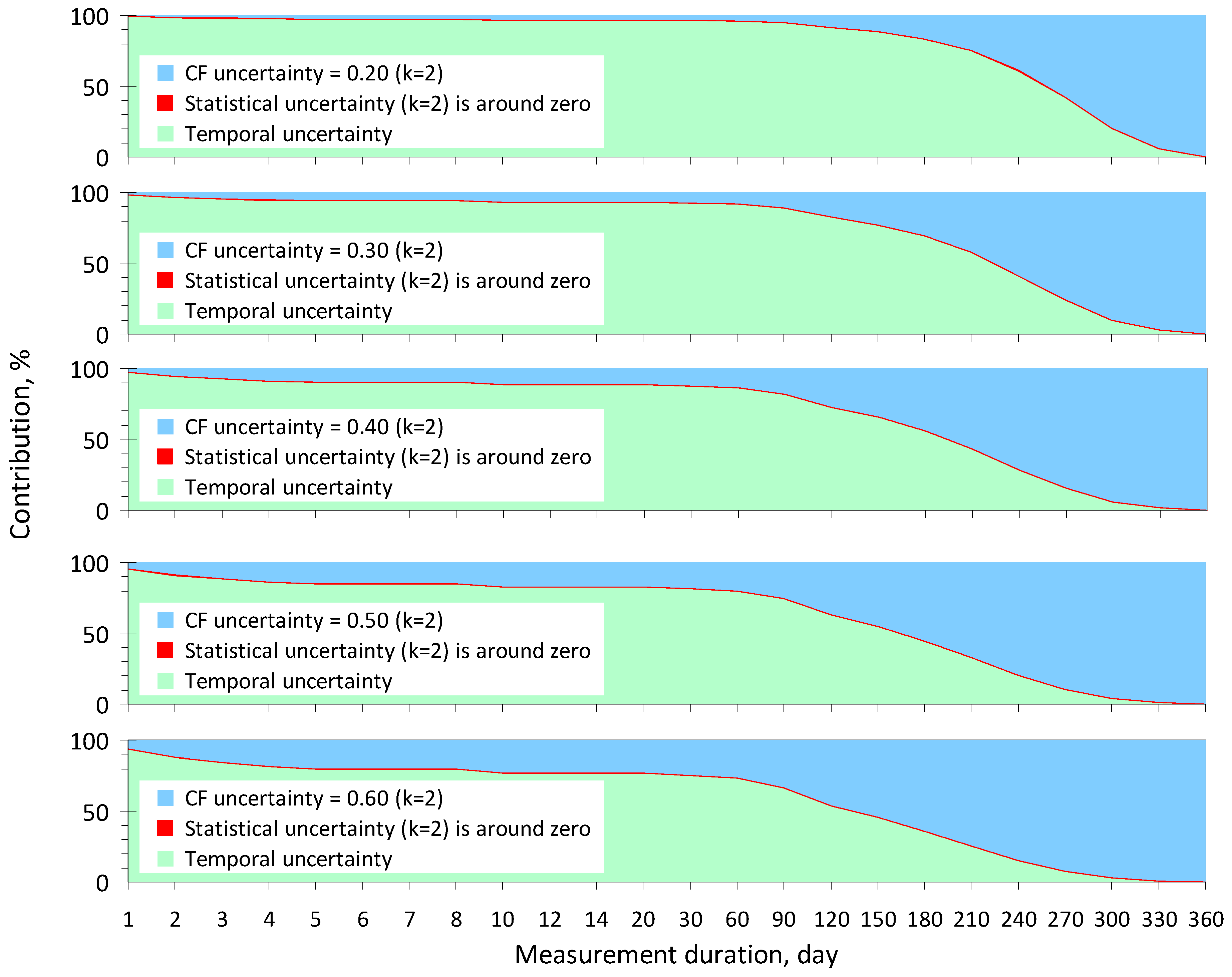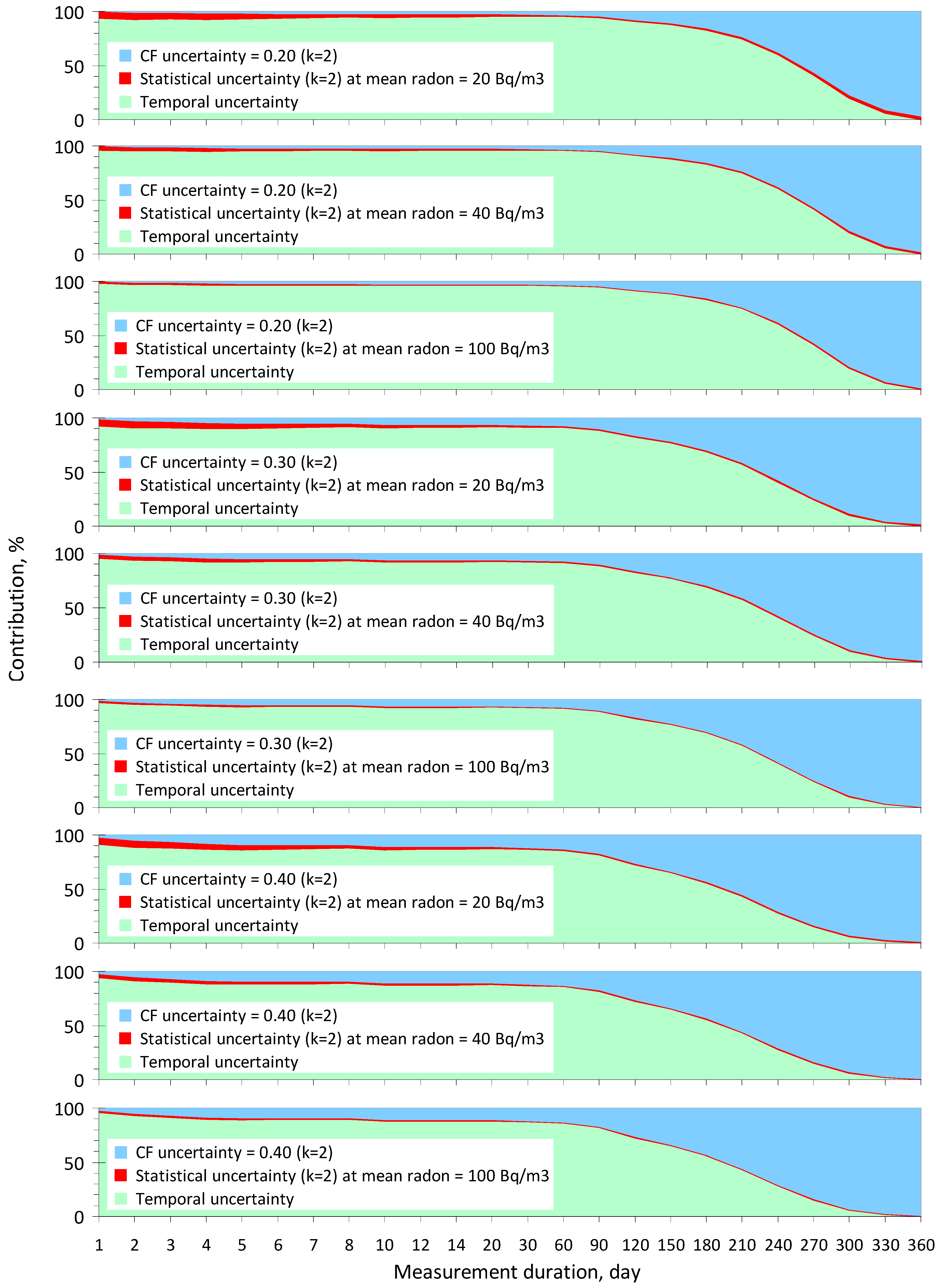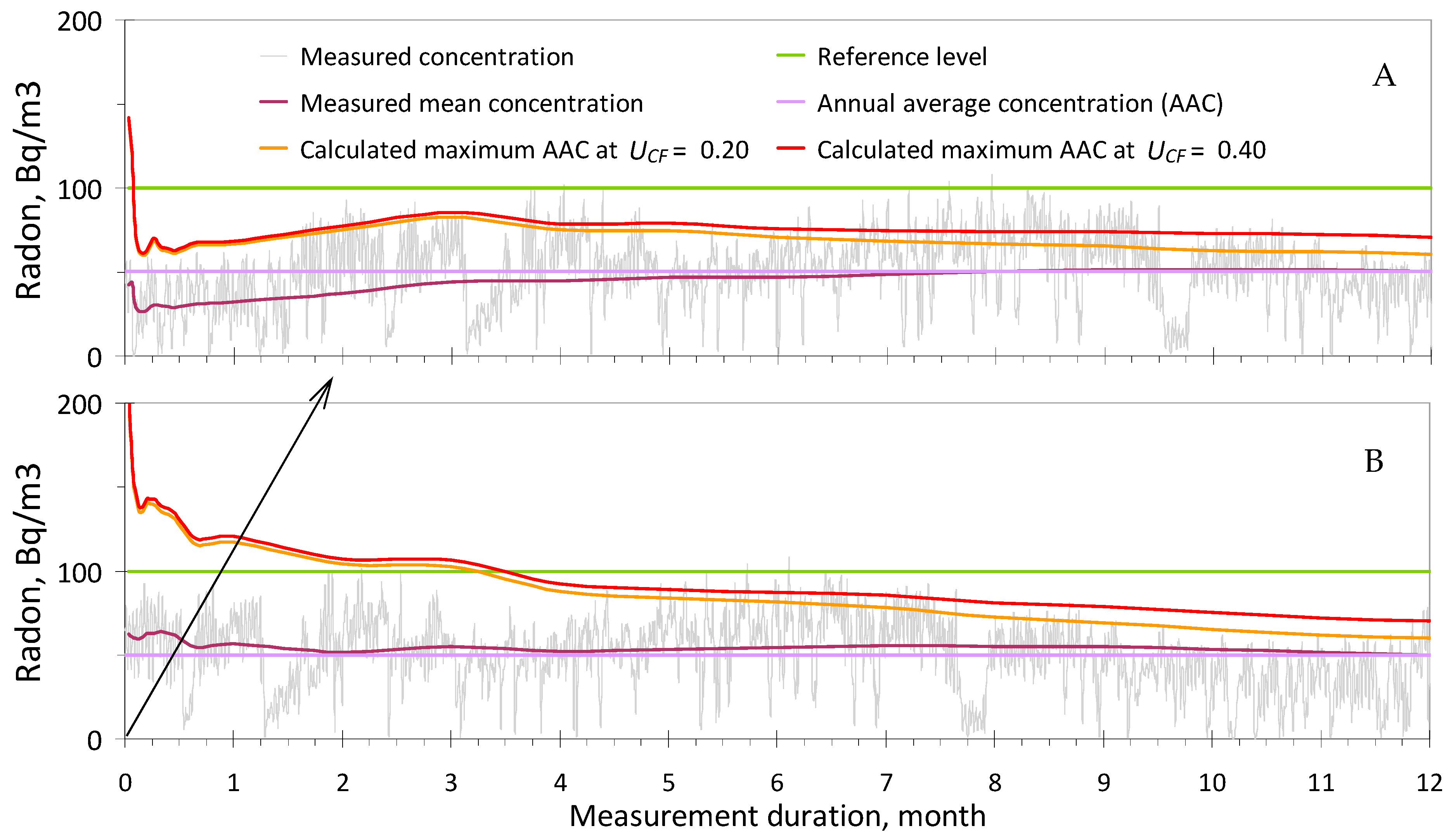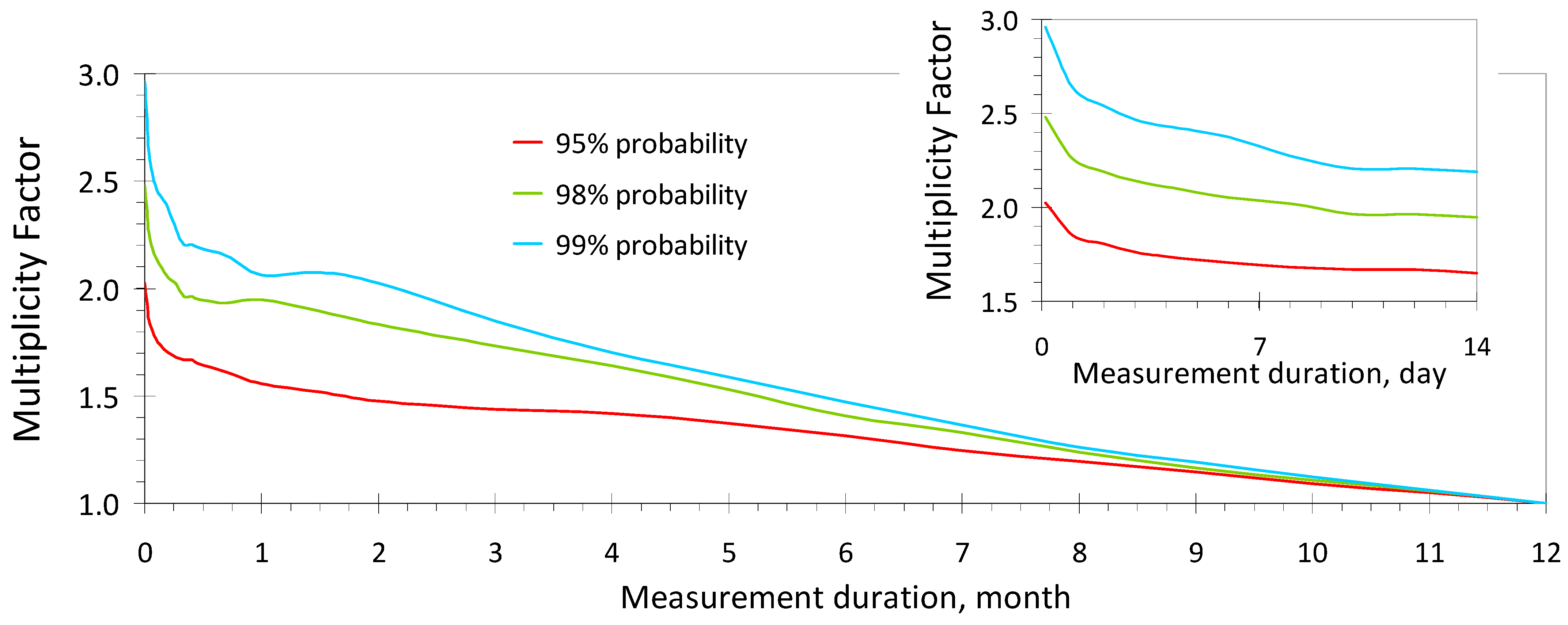Strategy and Metrological Support for Indoor Radon Measurements Using Popular Low-Cost Active Monitors with High and Low Sensitivity
Abstract
:1. Introduction
1.1. Indoor Radon: Risk and Regulation
1.2. Indoor Radon Survey Strategies and Consumer-Grade Active Monitors
1.3. Quality Assurance in Indoor Radon Measurement
1.4. The Temporal Aspect of Indoor Radon Measurements
2. Uncertainty Budget of Annual Average Radon Concentration
2.1. Rational Criterion for Conformity Assessment
2.2. The Temporal Uncertainty of Indoor Radon
2.3. Uncertainty of the Calibration Factor
- (a)
- relative biased error = (measured mean/true value) − 1;
- (b)
- relative standard deviation = standard deviation/measured mean.
2.4. Summary of Uncertainty Budget Components
- -
- From the temporal uncertainty:
- -
- From the CF uncertainty:
- -
- From the statistical uncertainty:
3. Characteristics of Low-Cost Radon Monitors
4. Results and Discussion
4.1. Composition of the Combined Uncertainty Budget
4.2. Assessment of Calibration Uncertainty
4.3. Verification of Monitor Sensitivity
4.4. The Problem of Background Control
4.5. Rational Measurement Strategy
4.6. Additional Criterion for Identifying Rooms with High Radon
4.7. Collection of Measurement Results
4.8. Recommendations to Manufacturers of Radon Monitors
- (a)
- Sensitivity (or calibration factor),
- (b)
- CF uncertainty at k = 2, using the term “calibration uncertainty” instead of “accuracy” in the specification,
- (c)
- Upper measurement range (the lower range depends on the sensitivity, CF and statistical uncertainties, measurement duration, and device background; therefore, it is preferable to indicate the device background instead of the lower measurement range, which has no practical significance in metrology for indoor radon measurements within Criteria (1) and (9)),
- (d)
- Device background as the maximum equivalent radon concentration (Bq/m3) acceptable for new and long-term-used monitors,
- (e)
- Calculated measurement duration (in hours or days) to achieve a statistical uncertainty of <0.10 at k = 2 (without considering the background) for a radon concentration of 100 Bq/m3,
- (f)
- Specification of the validity period of these metrological parameters (3 or 5 years).
- (a)
- Continuous indication and storage of measured radon concentration values with integration periods of 1 or 3 h for monitors with high sensitivity and 12 or 24 h for monitors with low sensitivity without using the principle of moving averages; outputting data every 10 min is unnecessary,
- (b)
- Continuous indication of the mean value of the radon concentration, C(t), after 3–6 h for monitors with high sensitivity and 1–2 days for monitors with low sensitivity after the start of the test (Figure 3), including the counting of the measurement duration in days,
- (c)
- Continuous indication of the instrumental uncertainty (UD) at k = 2 for both the current and mean radon concentrations,
- (d)
- Continuous indication of the current calculated (predicted) maximum annual average concentration of indoor radon (Figure 3) for comparison with the relevant reference level (RL) at the test location, beginning 2 days after its start,
- (e)
- Provision of relevant messages, including a recommendation for test completion if Criterion (1) or Criterion (9) is met after 4–6 days of testing,
- (f)
- Online display of recorded pulses or the mean pulse count rate (after the start of measurements), including the duration of measurements in hours and minutes, in a special mode, for example, “verification”,
- (g)
- Questionnaire for recording metadata, collecting test results (without personal data), and displaying them on a radon map with an updated design, according to Section 4.7,
- (h)
- It is also recommended to display the measured radon concentration even if the upper measurement range is exceeded, as there is no requirement to ensure accuracy at the level of the established CF uncertainty for radon concentrations exceeding 5000 or 10,000 Bq/m3.
5. Conclusions
Author Contributions
Funding
Institutional Review Board Statement
Informed Consent Statement
Data Availability Statement
Conflicts of Interest
References
- WHO. Housing and Health Guidelines; World Health Organization: Geneva, Switzerland, 2018; ISBN 978-92-4-155037-6. Available online: https://www.who.int/publications/i/item/9789241550376 (accessed on 6 May 2024).
- ICRP. Radiological Protection against Radon Exposure. The International Commission on Radiological Protection. ICRP Publication 126. Ann. ICRP 2014, 43, 5–73. Available online: https://www.icrp.org/publication.asp?id=ICRP%20Publication%20126 (accessed on 6 May 2024). [CrossRef] [PubMed]
- Radiation Protection and Safety of Radiation Sources: International Basic Safety Standards. IAEA Safety Standards Series No. GSR Part 3; International Atomic Energy Agency: Vienna, Austria, 2014; Available online: https://www-pub.iaea.org/MTCD/Publications/PDF/Pub1578_web-57265295.pdf (accessed on 5 May 2024).
- EU-BSS; Council Directive 2013/59/Euratom Laying down Basic Safety Standards for Protection against the Dangers Arising from Exposure to Ionizing Radiation Repealing Directives 89/618, 90/641, 96/29, 97/43 and 2003/122/Euroatom. Off. J. Eur. Union 2014. Available online: https://eur-lex.europa.eu/LexUriServ/LexUriServ.do?uri=OJ:L:2014:013:0001:0073:EN:PDF (accessed on 12 January 2024).
- Diário Oficial da União: Requisitos Básicos de Radioproteção e Segurança Radiológica de Fontes de Radiação; Resolução No. 323, de 28 de Março de 2024. Available online: https://www.in.gov.br/en/web/dou/-/resolucao-n-323-de-28-de-marco-de-2024-554935100 (accessed on 5 May 2024).
- WHO. National Radon Reference Levels, Data by Country. Available online: https://apps.who.int/gho/data/view.main.RADON03v (accessed on 12 January 2024).
- ANSI/AARST MAH. Protocol for Conducting Measurements of Radon and Radon Decay Products in Homes. 2023. Available online: www.radonstandards.us (accessed on 12 January 2024).
- ANSI/AARST MA-MFLB. Protocol for Conducting Measurements of Radon and Radon Decay Products in Multifamily, School, Commercial and Multi-Use Buildings. 2023. Available online: www.radonstandards.us (accessed on 12 January 2024).
- Tsapalov, A.; Kovler, K. Studying temporal variations of indoor radon as a vital step towards rational and harmonized international regulation. Environ. Chall. 2021, 4, 100204. [Google Scholar] [CrossRef]
- The US National Radon Action Plan 2021–2025. Available online: http://www.radonleaders.org/sites/default/files/2022-01/NRAP-2021-2025-Action-Plan-508.pdf (accessed on 12 January 2024).
- Rönnqvist, T. Analysis of Radon Levels in Swedish Dwellings and Workplaces; Research Report; Swedish Radiation Safety Authority: Stockholm, Sweden, 2021; ISSN 2000-0456. Available online: https://www.stralsakerhetsmyndigheten.se/contentassets/b27c66be9c79465aaa21b7d46b3bb14d/202128-analysis-of-radon-levels-in-swedish-dwellings-and-workplaces.pdf (accessed on 6 May 2024).
- Petermann, E.; Bossew, P.; Hoffmann, B. Radon hazard vs. radon risk—On the effectiveness of radon priority areas. J. Environ. Radioact. 2022, 244–245, 106833. [Google Scholar] [CrossRef] [PubMed]
- Holmgren, O.; Arvela, H.; Collignan, B.; Jiranek, M.; Ringer, W. Radon remediation and prevention status in 23 European countries. Radiat. Prot. Dosim. 2013, 157, 392–396. [Google Scholar] [CrossRef] [PubMed]
- Rábago, D.; Fernández, E.; Celaya, S.; Fuente, I.; Fernández, A.; Quindós, J.; Rodriguez, R.; Quindós, L.; Sainz, C. Investigation of the performance of various low-cost radon monitors under variable environmental conditions. Sensors 2024, 24, 1836. [Google Scholar] [CrossRef] [PubMed]
- Dimitrova, I.; Georgiev, S.; Todorov, V.; Daraktchieva, Z.; Howarth, C.B.; Wasikiewicz, J.M.; Sabot, B.; Mitev, K. Calibration and metrological test of the RadonEye Plus2 electronic monitor. Radiat. Meas. 2024, 175, 107169. [Google Scholar] [CrossRef]
- Dimitrova, I.; Georgiev, S.; Mitev, K.; Todorov, V.; Dutsov Ch Sabot, B. Study of the performance and time response of the RadonEye Plus2 continuous radon monitor. Measurement 2023, 207, 112409. [Google Scholar] [CrossRef]
- Mitev, K.; Georgiev, S.; Dimitrova, I.; Todorov, V.; Popova, A.; Dutsov, C.; Sabot, B. Recent work with electronic radon detectors for continuous Radon-222 monitoring. J. Eur. Radon Assoc. 2022, 3, 8844. [Google Scholar] [CrossRef]
- Warkentin, P.; Curry, E.; Oghenekome, M.; Bjorndal, B. A comparison of consumer-grade electronic radon monitors. J. Radiol. Prot. 2020, 40, 1258. [Google Scholar] [CrossRef]
- ISO 11665-8; Measurement of Radioactivity in the Environment—Air: Radon-222—Part 8: Methodologies for Initial and Additional Investigations in Buildings. International Organization for Standardization: Geneva, Switzerland, 2019.
- Tsapalov, A.; Kovler, K. Metrology for Indoor Radon Measurements and Requirements for Different Types of Devices. Sensors 2024, 24, 504. [Google Scholar] [CrossRef]
- Bossew, P.; Petermann, E. From data to decisions—Quality assurance in radon policy. J. Eur. Radon Assoc. 2022, 3, 7886. [Google Scholar] [CrossRef]
- Dicu, T.; Burghele, B.D.; Botoş, M.; Cucoș, A.; Dobrei, G.; Florică, Ș.; Grecu, Ș.; Lupulescu, A.; Pap, I.; Szacsvai, K.; et al. A new approach to radon temporal correction factor based on active environmental monitoring devices. Sci. Rep. 2021, 11, 9925. [Google Scholar] [CrossRef] [PubMed]
- Li, L.; Coull, B.; Koutrakis, P. A national comparison between the collocated short- and long-term radon measurements in the United States. J. Expo. Sci. Environ. Epidemiol. 2023, 33, 455–464. [Google Scholar] [CrossRef] [PubMed]
- Rey, J.F.; Goyette, S.; Gandolla, M.; Palacios, M.; Barazza, F.; Goyette Pernot, J. Long-Term Impacts of Weather Conditions on Indoor Radon Concentration Measurements in Switzerland. Atmosphere 2022, 13, 92. [Google Scholar] [CrossRef]
- Nunes, L.J.R.; Curado, A.; Lopes, S.I. Understanding Seasonal Indoor Radon Variability from Data Collected with a LoRa-Enabled IoT Edge Device. Appl. Sci. 2023, 13, 4735. [Google Scholar] [CrossRef]
- ISO/IEC Guide 98–3; Uncertainty of Measurement—Part 3: Guide to the Expression of Uncertainty in Measurement (GUM:1995). International Organization for Standardization and International Electrotechnical Commission: Geneva, Switzerland, 2008.
- ISO/IEC Guide 98–4; Uncertainty of Measurement—Part 4: Role of Measurement Uncertainty in Conformity Assessment. International Organization for Standardization and International Electrotechnical Commission: Geneva, Switzerland, 2012.
- JCGM 100:2008; Evaluation of Measurement Data—Guide to the Expression of Uncertainty in Measurement. (Joint Committee for Guides in Metrology). Available online: https://www.bipm.org/documents/20126/2071204/JCGM_100_2008_E.pdf/cb0ef43f-baa5-11cf-3f85-4dcd86f77bd6 (accessed on 6 May 2024).
- Kovler, K.; Tsapalov, A. A challenging path to rational and harmonized international regulation of indoor radon. Radiat. Prot. Dosim. 2023, 199, 1047–1055. [Google Scholar] [CrossRef]
- Tsapalov, A.; Kovler, K. Temporal uncertainty versus coefficient of variation for rational regulation of indoor radon. Indoor Air 2022, 32, e13098. [Google Scholar] [CrossRef]
- Tsapalov, A.; Kovler, K. Indoor radon regulation using tabulated values of temporal radon variation. J. Environ. Radioact. 2018, 183, 59–72. [Google Scholar] [CrossRef]
- Antignani, S.; Venoso, G.; Ampollini, M.; Caprio, M.; Carpentieri, C.; Di Carlo, C.; Caccia, B.; Hunter, N.; Bochicchio, F. A 10-year follow-up study of yearly indoor radon measurements in homes, review of other studies and implications on lung cancer risk estimates. Sci. Total Environ. 2021, 762, 144150. [Google Scholar] [CrossRef]
- Tsapalov, A.; Kovler, K.; Shpak, M.; Shafir, E.; Golumbic, Y.; Peri, A.; Ben-Zvi, D.; Baram-Tsabari, A.; Maslov, T.; Schrire, O. Involving schoolchildren in radon surveys by means of the “RadonTest” online system. J. Environ. Radioact. 2020, 217, 106215. [Google Scholar] [CrossRef]
- Cinelli, G.; Tollefsen, T.; Bossew, P.; Gruber, V.; Bogucarskis, K.; De Felice, L.; De Cort, M. Digital version of the European Atlas of natural radiation. J. Environ. Radioact. 2019, 196, 240–252. [Google Scholar] [CrossRef] [PubMed]
- Measurement Results Map by RadonTest Group. Available online: https://radonmap.online/indoorradon/ (accessed on 14 May 2024).




| Day | 1 | 2 | 3 | 4 | 5 | 6 | 7 | 8 | 10 | 12 | 14 | 20 |
| UV(t) | 2.30 | 1.60 | 1.40 | 1.25 | 1.20 | 1.20 | 1.20 | 1.20 | 1.10 | 1.10 | 1.10 | 1.10 |
| Month | 1 | 2 | 3 | 4 | 5 | 6 | 7 | 8 | 9 | 10 | 11 | 12 |
| UV(t) | 1.05 | 1.00 | 0.85 | 0.65 | 0.55 | 0.45 | 0.35 | 0.25 | 0.17 | 0.10 | 0.05 | 0.00 |
| Manufacturer | FTLab (Republic of Korea) | Ecosense (USA) | Airthings (Norway) | |
|---|---|---|---|---|
| Monitor model | RadonEye and RadonEye Plus2 | EcoQube | View Radon, View Plus, Wave Plus, Wave Radon, and Corentium Home | |
| Sensitivity level | High | Low | ||
| Sensitivity (or calibration factor) in cph at 1 Bq/m3/cpm at 1 kBq/m3 | 0.84/14 | 0.025 */0.42 | ||
| CF uncertainty (k = 2) | no data | no data | ||
| Upper measurement range ** (Bq/m3) | 3700 and 9435 | 3700 | 20,000 | |
| Device background as the maximum equivalent radon concentration (Bq/m3) acceptable for new/long-term used monitors | no data/no data | no data/no data | ||
| Statistical uncertainty | Manufacturer assessment | <10% at 370 Bq/m3 after 10 h | <10% at 200 Bq/m3 after 7 days | |
| Our assessment using (5) | <10% at 370 Bq/m3 after 1.5 (0.5) h at k = 2 (k = 1) | <10% at 200 Bq/m3 after 3.5 (1) day at k = 2 (k = 1) | ||
| <10% at 100 Bq/m3 after 5 h at k = 2 | <10% at 100 Bq/m3 after 7 days at k = 2 | |||
| Data lost (%) [14] | 2.2 and 2.4 | 18.9 | 0.8, 1.6, 6.1, no data for the last two models | |
Disclaimer/Publisher’s Note: The statements, opinions and data contained in all publications are solely those of the individual author(s) and contributor(s) and not of MDPI and/or the editor(s). MDPI and/or the editor(s) disclaim responsibility for any injury to people or property resulting from any ideas, methods, instructions or products referred to in the content. |
© 2024 by the authors. Licensee MDPI, Basel, Switzerland. This article is an open access article distributed under the terms and conditions of the Creative Commons Attribution (CC BY) license (https://creativecommons.org/licenses/by/4.0/).
Share and Cite
Tsapalov, A.; Kovler, K.; Bossew, P. Strategy and Metrological Support for Indoor Radon Measurements Using Popular Low-Cost Active Monitors with High and Low Sensitivity. Sensors 2024, 24, 4764. https://doi.org/10.3390/s24154764
Tsapalov A, Kovler K, Bossew P. Strategy and Metrological Support for Indoor Radon Measurements Using Popular Low-Cost Active Monitors with High and Low Sensitivity. Sensors. 2024; 24(15):4764. https://doi.org/10.3390/s24154764
Chicago/Turabian StyleTsapalov, Andrey, Konstantin Kovler, and Peter Bossew. 2024. "Strategy and Metrological Support for Indoor Radon Measurements Using Popular Low-Cost Active Monitors with High and Low Sensitivity" Sensors 24, no. 15: 4764. https://doi.org/10.3390/s24154764





